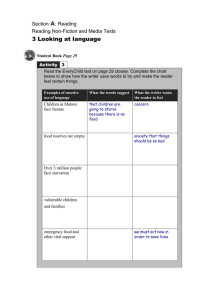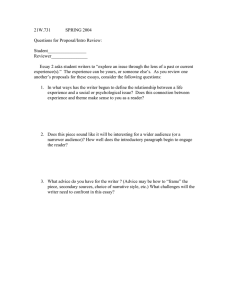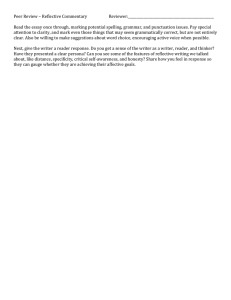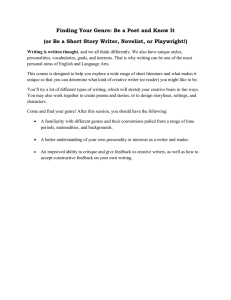8 Grade ELA Terminology Figurative Language
advertisement
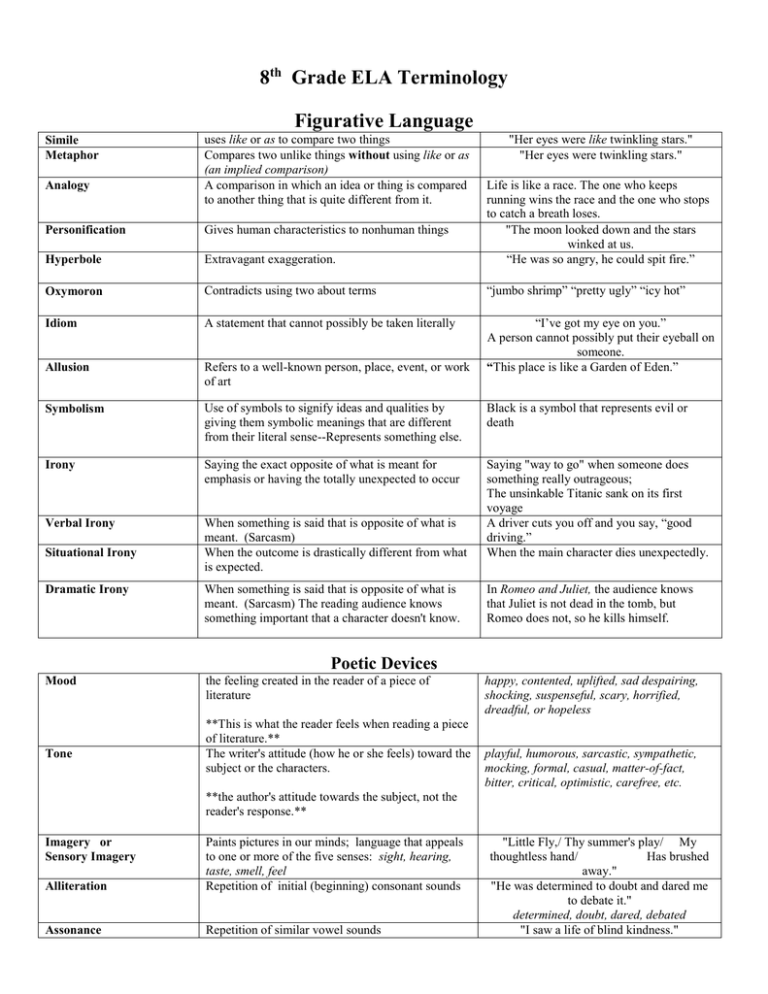
8th Grade ELA Terminology Figurative Language Simile Metaphor uses like or as to compare two things Compares two unlike things without using like or as (an implied comparison) A comparison in which an idea or thing is compared to another thing that is quite different from it. "Her eyes were like twinkling stars." "Her eyes were twinkling stars." Personification Gives human characteristics to nonhuman things Hyperbole Extravagant exaggeration. Life is like a race. The one who keeps running wins the race and the one who stops to catch a breath loses. "The moon looked down and the stars winked at us. “He was so angry, he could spit fire.” Oxymoron Contradicts using two about terms “jumbo shrimp” “pretty ugly” “icy hot” Idiom A statement that cannot possibly be taken literally Allusion Refers to a well-known person, place, event, or work of art “I’ve got my eye on you.” A person cannot possibly put their eyeball on someone. “This place is like a Garden of Eden.” Symbolism Use of symbols to signify ideas and qualities by giving them symbolic meanings that are different from their literal sense--Represents something else. Black is a symbol that represents evil or death Irony Saying the exact opposite of what is meant for emphasis or having the totally unexpected to occur Verbal Irony When something is said that is opposite of what is meant. (Sarcasm) When the outcome is drastically different from what is expected. Saying "way to go" when someone does something really outrageous; The unsinkable Titanic sank on its first voyage A driver cuts you off and you say, “good driving.” When the main character dies unexpectedly. Analogy Situational Irony Dramatic Irony When something is said that is opposite of what is meant. (Sarcasm) The reading audience knows something important that a character doesn't know. Mood the feeling created in the reader of a piece of literature In Romeo and Juliet, the audience knows that Juliet is not dead in the tomb, but Romeo does not, so he kills himself. Poetic Devices Tone **This is what the reader feels when reading a piece of literature.** The writer's attitude (how he or she feels) toward the subject or the characters. happy, contented, uplifted, sad despairing, shocking, suspenseful, scary, horrified, dreadful, or hopeless playful, humorous, sarcastic, sympathetic, mocking, formal, casual, matter-of-fact, bitter, critical, optimistic, carefree, etc. **the author's attitude towards the subject, not the reader's response.** Alliteration Paints pictures in our minds; language that appeals to one or more of the five senses: sight, hearing, taste, smell, feel Repetition of initial (beginning) consonant sounds Assonance Repetition of similar vowel sounds Imagery or Sensory Imagery "Little Fly,/ Thy summer's play/ My thoughtless hand/ Has brushed away." "He was determined to doubt and dared me to debate it." determined, doubt, dared, debated "I saw a life of blind kindness." Consonance Repetition of consonant sounds Onomatopoeia Symbols Words that imitate a sound Objects that stand for something else Rhyme Same or similar ending sounds at the ends of lines of poetry Internal Rhyme Does not contain end rhyme, but contains words that rhyme inside the lines of poetry (a word within a single line may rhyme with a word at the end of the same line) Life, blind, kindness “The ship has sailed to the far off shores.” Ship, sailed, shores buzz, hiss, pop! bang! pow! etc. Night, sleep, or black symbolize death in literature Roses are red. Violets are blue. Sugar is sweet, And so are you. Jack and Jill went up the hill To fetch a pail of water; Jack fell down and broke his crown, And Jill came tumbling after. Elements of a Story & Literary Elements Point of View First Person Third Person Omniscient Third Person limited Third Person Objective Conflict Internal Conflict External conflict Rising Action Climax Falling Action Resolution Theme Plot Setting Atmosphere Exposition Foreshadowing Style Characterization Direct Characterization Perspective from which the story is told. Who is telling the story? Everything that happens is through the narrator's eyes. The author tells the thoughts and feelings of more than one character. "all knowing" Only the thoughts and feelings of one character are revealed or described. The narrator gives an eyewitness account and tells only what can be seen or heard. The struggle, or problem, that the character faces. A struggle between two opposing desires within the character. Struggles or problems between the character and outside forces A series of events that builds from the conflict. It begins with the inciting force and ends with the climax. The turning point in the story or the point of the most intense feeling or excitement A series of events that lead to the close of the story, which results from the conflict. The final outcome of the conflict The insight into life or message that the author is conveying to the reader.(controlling idea) Sequence of events in a story The time and the place of a story. General climate created by the author Includes introductory material Clues the reader of something to come Use of sentence structure, words, dialects, and dialogue The way the author reveals a character's personality or nature. The author describes the character or makes I, we, us, our, me They, them, he, she, it, etc. The story is not told with I. They, them, he, she, it, etc. The story is not told with I Being a eyewitness to an accident, fight or crime. Individual vs Individual Individual vs Nature Individual vs Society Individual vs the Supernatural Individual vs Animal Everything before this event is leading to it and everything after this event happens because of it. It comes at the end of the story.(ties up the "loose ends" of the story) The theme can be stated or implied. Gives the setting, sets the tone, presents the characters, and other facts necessary to understanding the story "Jordan at five is a sweet but mischievous statements about the character. Indirect Characterization The readers know about the characters through their words, thoughts, actions, or other character's words or thoughts about them. Dialogue Monologue Protagonist Antagonist Round character Dynamic character Conversation between 2 or more people A conversation involving one person. The main character. The person who causes trouble for the protagonist Shows many traits-faults and virtues Encounters conflict and changes. The character is more developed than described. Character whose actions parallel Stereotyped character Minor character who does NOT change Predictable, simple, undeveloped character who remains unchanged throughout Original model or pattern from which other later copies are made Larger than life character who goes on some type of journey (spiritual and/or physical) Inform Entertain Persuade Describe Foil Stock character Static character Flat character Archetype Hero Author's purpose Author's intent Fiction Non-Fiction Writing that is not true. It is from the author’s imagination Writing that is not imaginary. girl who loves to dress up and play pretend games." "The husband was angry with his wife. "That bag of lettuce is half empty. Why didn't you try to get one that had more in it? I can't believe you didn't look at the bag more carefully a the grocery store." The husband is picky and critical. A conversation between friends A person talking to themselves The good guy The bad guy The Pearl is not true just a story. Newspaper articles, magazine article Non-fiction Text Structure Sequential order Chronological order Description Cause and Effect Procedure Compare and Contrast Order of Importance Problem Solution Events are in the order in which they occurred. Written or verbal picture of a character, setting, event, item, etc. Writer tells an event or condition that causes things to happen Sequence of tasks, steps, decisions, or processes The writer presents two or more things that are both alike and different The writer list facts and details starting with the most important. Each subsequent detail is less important than the one before. The writer describes a current problem and proposes a solution Classification The writer groups similar things into categories. Appendix Found at the end of the book. It is not part of the main text but provides related information Found at the end of the book. It is a list of subjects covered. Located in the front of the book. Outline of the sections in the book. Located at the bottom of the page of the text and provides additional information Additional information located in a boxed in area usually beside or below the article Smoking (Cause) Cancer (Effect) Recipes, instructions to a game, etc. European Football and American Football A newspaper article my describe the traffic flow problem and offer a solution to the problem. Popular music Rap, pop, country, R&B, etc. Text Features Index Table of contents Footnote Sidebar Maps, statistical tables, charts, graphs Magazine article on cancer. Sidebar may have tips for early detection. Glossary A list of definitions of words used in the book Modes of Writing Formal Informal Narrative Expository Persuasion Summarizing Paraphrase Polished, professional writing. Does not contain contractions, slang. The word choices are of higher level (follows the rules of grammar) Contains contractions, slang, local word choices (used in relaxed conversational settings) The writer is telling a story. The writer is informing its audience Legal documents, speeches “I can’t come to your house.” My like Mountain Dew. Why? The writer is trying to get the audience to believe or do something. Reading a text and restating just the main points in the writer’s own words. Usually short Reading a text and restating the text in the writer’s own words. Propaganda Propaganda Stereotype 1. Card Stacking 2. bandwagon language 3. endorsement 4. False Syllogism 5. Glittering generalities 6. Name calling 7. Shock Tactics 8. Association 9. Plain Folks Technique 10. Slanted words 11. Tabloid thinking Sarcasm Satire Fact Opinion Uses emotional tactics to sway opinions. Not individual but representative of a group with a set of characteristics Presenting only facts that support your viewpoint. Not telling the whole story. Uses peer pressure to convince the reader to act. Using a famous person to advertise a product. An argument made on two premises that doesn’t lead to the correct conclusion. Abstract words assumed to have positive meanings Use of negative labels to attack a person or a group Using fear to persuade people to do something. If you’re a friend of someone who did something bad then you must be guilty The speaker tries to connect with simple values and down-to-earth people Words carefully chosen to change to meaning of something A generalization that oversimplifies the issue Remarks that clearly mean the opposite of what is said. Usually designed to be hurtful, mocking, reproachful Using biting wit, irony or sarcasm to expose some form of corruption or problem in society. Something that is known to be true or can be proven. Something that is a belief or a judgment usually not shared by all people. Advertisements Blonde females, computer nerds, etc. "join the crowd" "don't be left behind" "everybody's doing it" Michael Jordan and Nike National teacher awards are given to great teachers. Mr. Knowle didn’t get the award Mr. Knowle is not a good teacher. Patriotism, democracy, freedom, honor Mayor Robbins is a dirty crook. If this bill passes, our schools will decline. Our students want be able to compete in the job market. I saw Nancy talking to that trouble maker boy, so she must be a trouble maker too. We’re good down-home folks. We know what Jumpertown needs. You can’t change human nature "That guy she is dating is a piece of work; he's a real winner. Late night shows such as David Letterman, Jay Leno Apples can be green, yellow, or red. Apples are a delicious snack. VOCABULARY Denotation The dictionary definition Connotation The implied meaning Word Roots Affixes Base words with simple meanings Parts that are added to beginning or ending of root words to make another word Additions to end of words to change a word’s meaning Additions to end of words to change a word’s meaning Two words spelled and pronounced alike but have different meanings. Words, phrases, and sentences that give a clue to the meaning of a word Proving that something is right or reasonable. Using the facts or the information in the text to come to a logical(reasonable)conclusion Examine a text for its worth or beauty. Examine a text for reasons why author used certain elements or what those elements mean. Suffix Prefix Homonyms Context Justify Infer Critique Analyze Evaluate Supporting Details Valid Conclusion Childlike: like a child Attractive: pretty or beautiful Childlike: innocent or trusting Attractive: (attractive offer)favorable act is the root to activity overlooking action ion is the suffix proceed Bow - to bend at the waist Bow – the front of a ship Look inside the sentences the find the meaning of the word. Author uses the color black in text. Why did the author use black? What does black symbolize? What is the connotation of black? Examine and judge the quality of something. There is a main idea. The supporting details are what backs up the main idea. The reader comes to a decision about the text based upon what is included in the text. Resources or Reference Materials Thesaurus Contains words and their meanings Correct spelling, pronunciation, word origin, grammatical usuage, synonyms and and antonyms A book of words and the synonyms for those words Encyclopedia Contains many short articles on numerous subjects Dictionary Almanac Electronic Dictionary – Dictionary online Factual information that is pertinent to the present and the past about people, places, and events. Contains records set or broken in sports, information about the weather, Oscar winners, agricultural information, etc. Submerge v 1: to put or go under the surface of the water 2: inundate Difficult -- hard, tough, troublesome, toilsome, irksome, laborious, onerous, arduous, formidable Use to do research and find facts on the solar system. Atlas Book of maps and other useful information To find the current population of Booneville, MS To find who holds the record for the most Olympic gold medals. To find out the total rainfall for Prentiss county in 2003. To plan the best route to take from Booneville to Daytona Beach, Florida To find the distance between Booneville and Memphis To find the population of Alaska. Internet The World Wide Web One needs a computer to connect to the Internet Synthesize Combine information from two or more sources to produce written information. To determine the highest point in Mississippi To study the map of Mexico Recipes Research topics Order products Read newspapers and magazines Send email Play games Puts ideas together from various sources to make a reasonable observation (getting the "big picture")
